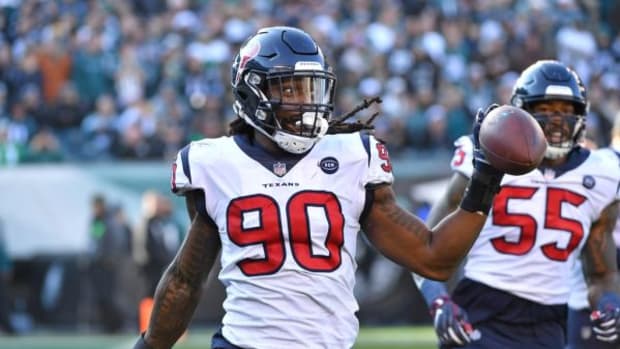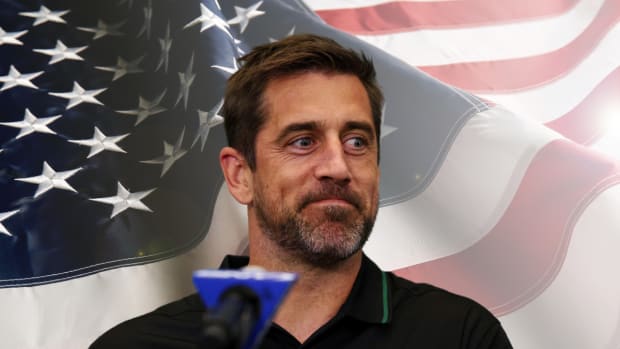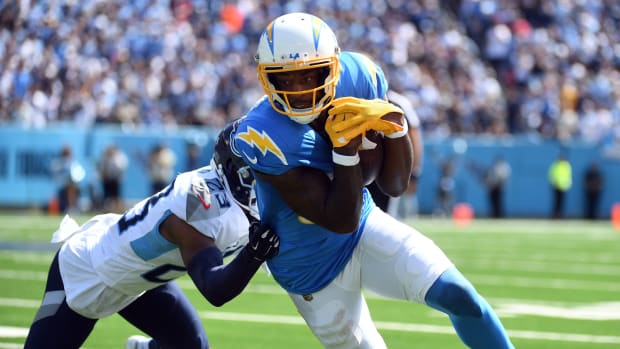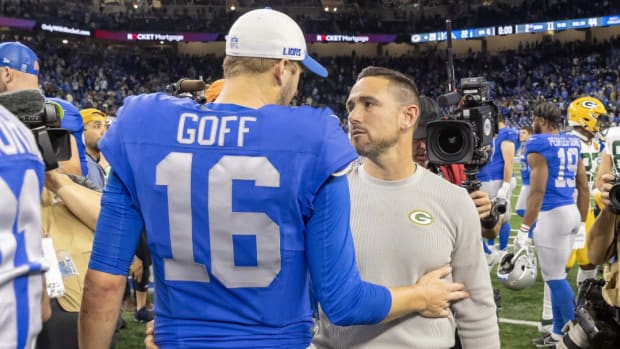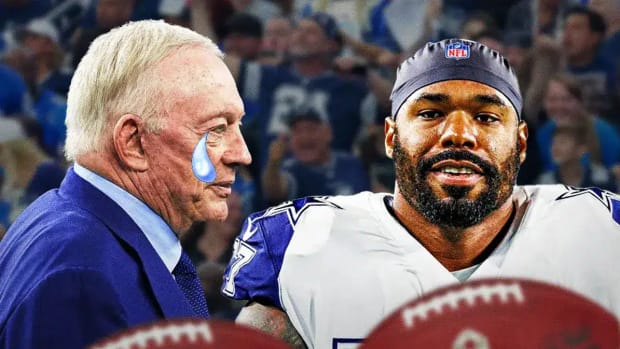What Ails Them, and Maybe a Cure
Chad Henne, who stepped in against the Rams, shows more pocket presence than Blaine Gabbert; his problem is inaccuracy. (L.G. Patterson/AP)
This Sunday’s game in Denver between the 0-5 Jaguars and the 5-0 Broncos is anticipated to be a mismatch of historic proportions. This week The MMQB is exploring what it’s like for the Jaguars to be the NFL’s biggest underdog ever, whether there’s hope for the season—and the future—in Jacksonville, and how the Jags and the league’s other winless teams might turn things around. Read the entire series, and check back each day this week for more.
The intent here is not to embarrass, mock or ridicule the Jaguars. This week’s record-setting 28-point Vegas spread pretty much takes care of that. Nor is the goal to condemn rookie general manager Dave Caldwell, first-time head coach Gus Bradley or owner Shad Khan. Despite Jacksonville’s 0-5 start, most NFL insiders still believe Caldwell and Bradley were smart hires. Khan has been in charge less than two years and has been forced to focus mostly on the business model of his small-market franchise. At this point, the only thing we can fault Khan for is his bad taste in uniforms. The rest is still to be determined.
The purpose of this article is to analyze what’s wrong with the Jaguars and to shed light on whatever slivers of optimism might remain for this season. We’ll do this by breaking down the position groups on both sides of the ball, starting with the most problematic ones. You might want to cover your eyes ...
OFFENSE
New coordinator Jedd Fisch wants to play up-tempo. That’s tough to do when your unit goes three-and-out roughly two out of every five drives.
Quarterback
The Problem: Blaine Gabbert has been afflicted with injuries—a lacerated thumb in Weeks 2 and 3; a hamstring that knocked him out of last week’s game against the Rams and will keep him out this Sunday—but even when healthy he has struggled. Gabbert’s main drawback continues to be his disturbing tendency to perceive pressure. He has no pocket poise or awareness. Here’s just a snippet of the myriad evidence:
Some believe this is a weakness that can’t be overcome. There’s no way to teach a quarterback to not play scared, and there’s no way to design viable passing plays if he’s being ruled by fear. If the Jaguars’ brass feel this way, we’ll see backup QB Chad Henne starting full-time very soon. The 6-3, 230-pound ex-Dolphin has always been willing to hold his ground and make throws with pressure bearing down. The problem, however, is that too many of his throws are off target.
Sliver of optimism: When Gabbert has functional space, he flashes the arm strength that got him drafted 10th overall in 2011. He can zip the ball with precision and confidence, particularly when throwing to receivers in the seams. Unfortunately, functional space is hard for quarterbacks to come by in the NFL, which is why Gabbert’s future here looks dim.
Receivers
The problem: None of the receivers have been able to free themselves from man coverage. There’s not much more to say, really. If a receiver can’t shake man coverage, he must be able to make contested catches. (See Boldin, Anquan.) Cecil Shorts has not done that. Neither has Ace Sanders. Nor Stephen Burton. At 6-6, 275, tight end Marcedes Lewis has the build to make contested catches, but a calf injury has sidelined him for all but three snaps this year. Backup tight end Clay Harbor runs pretty well after the catch, but he and fellow tight end Allen Reisner have been mostly nonfactors.
The return of Justin Blackmon added some spark to the offense—but his big plays in St. Louis came on busted coverages. (Tom Gannam/AP)
Sliver of optimism: Justin Blackmon returned to face the Rams last week following a four-game suspension for violating the league’s substance abuse policy. He scored a 67-yard touchdown the first time he touched the ball. But that catch, just like his 39-yarder, came against busted coverage. Blackmon also lacks the quickness and agility to consistently beat man coverage, but he can make plays when he’s afforded spacing early in his route. The Jags can use pre-snap motion and stack release concepts to create opportunities for him and spark their aerial game.
Offensive Line
The problem: Rookie left tackle and second overall pick Luke Joeckel is gone for the year with a broken ankle. And his predecessor, Eugene Monroe, was traded to Baltimore just last week. The Jags will now try their luck with Cameron Bradfield on the left side and Austin Pasztor on the right. The undrafted Bradfield started 12 games at right tackle last season and became every defensive end’s best friend. The undrafted Pasztor showed limited athletic range in his first NFL start last week. Amazingly, this line might be even more suspect inside, as left guard Will Rackley and center Brad Meester have consistently been overpowered in both run blocking and pass protection. Right guard Uche Nwaneri also struggled in Week 5.
Sliver of optimism: There’s always the possibility that a defensive lineman will slip and fall.
Running Back
The problem: As you might imagine, defenses are dialing in on Maurice Jones-Drew. The eighth-year veteran has been held to 2.8 yards per carry (his career average is 4.5). In past years he was at least able to get involved in the passing game. But not anymore. The longest of Jones-Drew’s six catches (on 12 targets) has gone for 11 yards. The players behind Jones-Drew, including rookie “offensive weapon” Denard Robinson, have not shown much.
Sliver of optimism: If Blackmon can stay in the lineup, and if Marcedes Lewis ever returns, the Jaguars can start diversifying their formations. This would prevent defenses from focusing solely on the backfield.
DEFENSE
The Prescription
What's to come in 2014? Check out Andy Staples' dream draft to fix the Jaguars.
Gus Bradley and his coordinator, Bob Babich, would like to play fundamentally sound zone coverage behind a fast four-man pass rush—just like Bradley did as the coordinator in Seattle and Babich did in Chicago. Unfortunately, they don’t have the same resources anymore.
Defensive Backfield
The Problem: Due to injuries, the Jaguars haven’t played with all four of their starting defensive backs since Week 1. Which isn’t to say they had a sensational secondary to begin with. Top corner Dwayne Gratz is a third-round rookie. No. 2 corner Alan Ball was a dimeback in Dallas and Houston. Nickelback Will Blackmon was signed right before the season started, which tells you that late-round youngsters Demetrius McCray and Mike Harris aren’t ready for significant playing time. But that’s precisely what McCray and Harris have gotten, thanks to Gratz’s ankle injury and Ball’s groin injury (from which he recently recovered). McCray, with his undeveloped ball awareness, has been particularly vulnerable in one-on-one scenarios on the outside.
At safety, starter Dwight Lowery missed the last two weeks with a concussion. Sixth-rounder Josh Evans has taken his place, forming a rookie tandem with No. 33 overall pick Jonathan Cyprien. Cyprien has played every snap this season and shown good athleticism in the box. But he’s also shown his inexperience in coverage.
Sliver of optimism: Despite the youth and turnover in personnel, there have been several encouraging stretches where this group has played its staple Cover 2 and Cover 3 zones with discipline and intelligence. The group figures to only get better as the season progresses.
Defensive Line
The problem: A scheme like Bradley’s depends on having a disruptive front four. Jacksonville’s front has often delivered against the run (new defensive tackles Roy Miller and Sen’Derrick Marks have good initial movement and strength in slant-crashes). There’s been less consistency against the pass. The high-motored Tyson Alualu has generated some interior penetration from his new end position, and veteran Jason Babin can skim the corner. But overall pressure has not been there consistently, and top backups Andre Branch and Jeremy Mincey (currently injured) have provided minimal help.
Sliver of optimism: There’s talent and veteran experience along this front four. If everyone stays healthy, it should emerge as the strength of this team.
Linebacker
JAG WEEK
In the lead-up to Jacksonville’s game at Denver, with the largest point spread in NFL history, The MMQB is looking at the Jags from a variety of angles. Read the other stories in the series here.
The Problem:
Offenses have attacked Jacksonville’s second level with misdirection concepts like rollouts, play-action and reverses. For the most part, Paul Posluszny, Geno Hayes and Russell Allen have responded well, but they’ve often been soundly defeated when offensive linemen make contact with them.
Sliver of optimism: Posluszny will ultimately prove that he can shed blocks just fine. As long as the D-line keeps this group clean, it can play with impactful downhill speed.
SPECIAL TEAMS
The problem: Despite all the extra in-game practice that Jacksonville’s punting unit has had this season, it still ranks near the middle of the pack in net average. Jacksonville’s return game was expected to be galvanized by Denard Robinson, but he has not beaten out Ace Sanders or Will Blackmon—who, by the way, have combined for 17 yards on nine punt returns.
Sliver of optimism: Sanders did have a long punt return called back by a penalty last week. Better than nothing, even if it didn’t count.
Now, on to the other three winless teams . . .
Tampa Bay Buccaneers
Defense has not been the problem in Tampa Bay; it’s quarterbacking and pass protection. (Al Tielemans/Sports Illustrated)
The Problem: Their quarterback play has been erratic. And, of course, they’ve taken measures to address this. Rookie Mike Glennon looked decent in his first start against the Cardinals in Week 4. He’s a disciplined, classic pocket passer. As long as his protection is sound, he gives the play designs a chance to fully develop.
There’s some question about those play designs, though. Many of them involve downfield isolation routes. That’s fine for big, talented receivers like Vincent Jackson and Mike Williams, but it calls for a lot of anticipatory, tight-windowed throws by the quarterback. Glennon struggled with that against Arizona, particularly when throwing to his left to Jackson. (It didn’t help that Jackson was rarely able to separate from Patrick Peterson.)
Then there’s the issue of pass protection. The Bucs have been solid against the four-man rush, but they’ve had trouble reacting to the blitz. The inexperienced Glennon cannot be expected to always recognize convoluted sub-package pass-rush attacks; his O-line and running backs must do a better job picking up the slack.
Sliver of optimism: Tampa Bay’s defense is fantastic. You can question Greg Schiano’s and coordinator Bill Sheridan’s decision to play zone on practically every down. (Why trade for Darrelle Revis if you’re not going to use him as a shutdown corner?) You can’t, however, question the Bucs’ effectiveness in zone. The secondary has been stellar and the young linebackers have compensated for a somewhat underwhelming pass rush by playing with speed when blitzing and in coverage.
Pittsburgh Steelers
Troy Polamalu is back to his devastating self, but the Steelers defense has yet to record a takeaway. (Justin K. Aller/Getty Images)
The Problem: You know about Pittsburgh’s downtrodden offense. The front line has been deplorable, the receivers have been unimpressive and, with Le’Veon Bell not making his debut until Week 4, the running game has been nonexistent.
No sense diving any deeper into the obvious; let’s examine the “vaunted” Steeler defense instead. It ranks a respectable 10th in yards per game, but it’s the only unit that hasn’t forced a turnover in 2013. In fact, it’s the only unit that hasn’t forced at least two turnovers in 2013. It also ranks dead last in sacks per game (1.0; and without LaMarr Woodley, it’d be 0.25).
The essence of Dick LeBeau’s zone-blitz scheme is to use as few defenders as possible in generating pressure. That’s the biggest factor in the turnover formula. This season, with Troy Polamalu healthy and two uniquely athletic rookies, linebacker Jarvis Jones and safety Shamarko Thomas, playing significant snaps (a major rarity for this defense), LeBeau has been even more diverse than usual in his sub-package designs. The results just haven’t been there.
A paucity of big plays also marred this defense a year ago. Despite a pass rush that registered almost 2.5 sacks per game, they failed to generate more than 20 turnovers. This year the Steelers have allowed more yards on the ground and through the air, but those numbers are somewhat inflated by the trip to London, where a handful of normally dependable guys seemingly left their tackling skills at customs.
Overall, this defense has solid players. But the unit hasn’t been consistent or dynamic enough.
Sliver of optimism: If Polamalu stays healthy, it seems inevitable that this D will start cashing in on opportunities. Plenty have been there.
New York Giants
Yep, it’s been that kind of start for Eli Manning, who’s been forcing passes thanks to breakdowns in his blocking. (Drew Hallowell/Philadelphia Eagles/Getty Images)
The Problem: Severe offensive line woes have prevented the Giants from finding any sort of rhythm. Quarterback Eli Manning has tried to compensate by forcing balls into coverage, mostly with disastrous results. It was encouraging to see Hakeem Nicks catch nine passes for 142 yards against Philadelphia—perhaps he and Manning can rediscover their once-potent chemistry. In 2011, Nicks was as good as anyone at creating just enough separation at the top of a route. He must start doing this again. (It won’t be easy against the Bears on Thursday night; Chicago cornerback Charles Tillman, who generally shadows the opposing team’s biggest receiver, is one of the best in the league at repositioning his coverage when the ball is in the air.)
Also hindered by the offensive line, tailback David Wilson has been so preoccupied with not fumbling that you’d never guess he has the speed and explosiveness of a first-round pick. Wilson has regained some of his form over the past two weeks but still has a long way to go.
On the other side of the ball, New York’s once-venerated four-man pass rush remains dormant. Jason Pierre-Paul, four months removed from back surgery, is clearly not himself. Justin Tuck has been versatile and disruptive, but the production isn’t there. Mathias Kiwanuka has only 1.5 sacks. Which, sadly, is only two fewer than the rest of the team combined. The Giants’ linebackers and defensive backs are not good enough to survive behind a tepid pass rush.
Sliver of optimism:












































